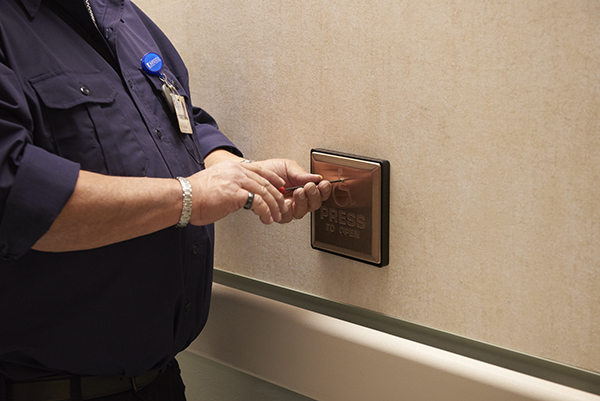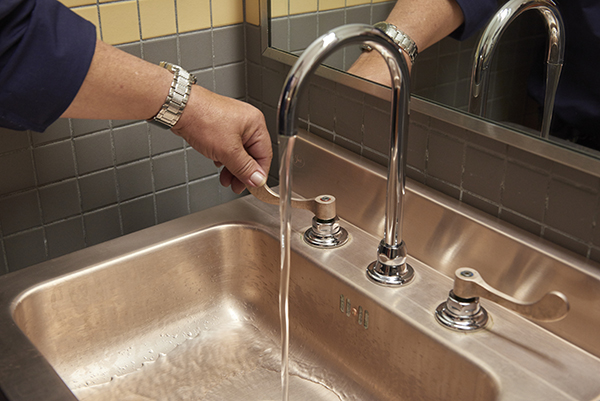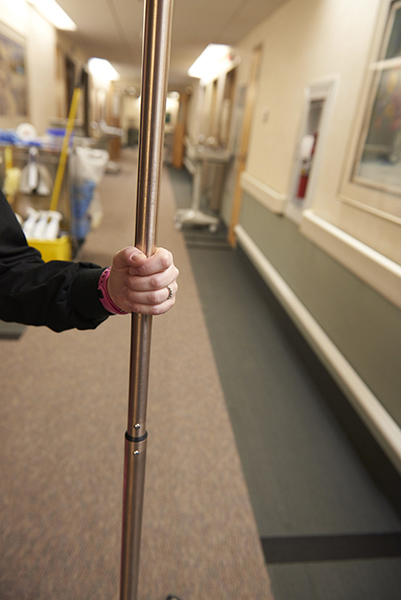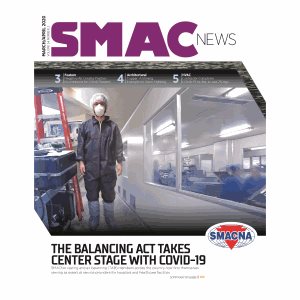Copper: A Shining Example for Germ Fighting
As scientists look for ways to battle the highly contagious coronavirus directly through vaccines, other researchers are studying copper as as a way to potentially prevent its spread in everyday settings.

Some areas in public buildings, such as this handicap access automatic door button, are repeatedly touched by people daily. Installing hardware that contains copper alloys can reduce the spread of viruses, bacteria and fungi, researchers say. Pictures courtesy of Copper Development Association.
 As scientists look for ways to battle the highly contagious coronavirus directly through vaccines, other researchers are studying a metal which goes back thousands of years as a way to potentially prevent its spread in everyday settings.
As scientists look for ways to battle the highly contagious coronavirus directly through vaccines, other researchers are studying a metal which goes back thousands of years as a way to potentially prevent its spread in everyday settings.
With experts saying a vaccine for COVID-19 is unlikely for at least a year, what if increased use of a common metal could help slow the virus’ spread now?
It’s a question more medical experts are asking after a study recently published in the New England Journal of Medicine titled “Aerosol and Surface Stability of SARS-CoV-2 as Compared with SARS-CoV-1” attempted to determine how long the novel coronavirus could live on surfaces typically encountered by the public in a normal day.
The study, conducted by government and university scientists, said COVID-19 could survive for 24 hours on cardboard, two to three days on plastic and stainless steel surfaces, and just four hours on copper.

The fact that coronavirus doesn’t last as long on copper surfaces is not a surprise to those who study the naturally occurring metal and its related alloys. Copper’s antimicrobial properties have been known for thousands of years and were exploited by the ancient Egyptians and Greeks. Since 2008, the U.S. Environmental Protection Agency has allowed the registration of more than 500 antimicrobial copper alloys, permitting public health claims that the metals are capable of killing harmful bacteria.
Larry Peters, a project manager with the Copper Development Association and expert in architectural metals and the unique health properties of copper, agrees. Although the natural disease-fighting capabilities of copper are not surprising to many researchers, the broader medical community may not be as aware of them, Peters said.
“We’ve seen muted success in the hospital and health care markets, where much of the industry’s product development was initially targeted,” he said. “There is general awareness by health officials and the construction industry regarding the antimicrobial properties of copper alloys, but there is a need for more education on how to practically implement antimicrobial copper surfaces in building designs and health care systems.”

Considering that there are numerous surfaces in every hospital — from call buttons and tray tables to railings and switch plates — that are repeatedly touched by patients, visitors and staff, it would seem like health care facilities are ideal for copper’s antimicrobial applications. That position is reinforced by numerous studies, Peters pointed out.
“There is an extensive body of peer-reviewed evidence spanning several decades that demonstrates the broad-spectrum antimicrobial efficacy of copper alloys against viruses, bacteria and fungi,” he said. “Antimicrobial copper offers a proven, attractive, cost-effective solution to reducing health care-acquired infections, patient in-hospital stays, and treatment costs due to infection.”
The worldwide awareness among researchers and the public that viruses such as COVID-19 can survive and spread through high-contact public areas offers an opportunity to raise the profile of copper among the health care community, Peters said.
“One thing we can do to short circuit the chain of infection is to strategically deploy continuously active copper alloy surfaces in high-touch areas,” he said. “By depleting the reservoir of pathogens in the built environment, we can reduce the risk of transmission.”
And unlike social distancing and frequent hand washing, Peters added, copper and its alloys work to fight disease without depending on humans to follow guidelines, making them an ideal supplemental line of defense.
As experts in indoor air quality and building environments, he said sheet metal contractors have an important role to play in this educational effort.
“SMACNA contractors have a new weapon they can deploy and advocate for in the fight against infectious disease,” Peters said. “Incorporating antimicrobial copper alloys into product and system designs provides 24/7 public health protection. Heat exchanger fins, ductwork, drip pans and other HVAC components can be a breeding ground for human pathogens. Utilizing copper alloy materials in HVAC components can help reduce the potential transmission of pathogens in these systems.”
Just like H1N1, SARS and Spanish flu, it’s unlikely that coronavirus will be the last pandemic to impact the world’s populations. The CDA says copper can be an integral part of efforts to contain and combat such illnesses.
“We have only scratched the surface, and more facilities and industries will need to embrace the capabilities of antimicrobial copper materials to help mitigate the impact of future outbreaks and pandemics,” Peters said. “We’ll need to think differently about how we can ‘vaccinate’ the surfaces in our environment through the strategic deployment of scientifically proven antimicrobial surfaces like copper alloys.”
Published: March 31, 2020
IN THIS ISSUE
Capitol Hill Update: Pension Reform Amid COVID-19 Legislative Frenzy
Contractor Completes COVID-19 Facility in Just 21 Days
Copper: A Shining Example for Germ Fighting
As scientists look for ways to battle the highly contagious coronavirus directly through vaccines, other researchers are studying copper as as a way to potentially prevent its spread in everyday settings.
Covid-19 Ripple Effects: Turning Crisis into Opportunity
What can we do as construction business owners, post-pandemic, to survive and thrive while the country climbs out of this mess?
Jason Watson Promoted to Executive Director, Labor Relations
Jason Watson has been promoted to executive director of labor relations at SMACNA National effective April 26. He previously served as director of labor relations at SMACNA for more than 15 years.
Mobilizing for the Future: Asset Management
As the world experiences increased uncertainty due to the COVID-19 pandemic, the importance of the construction industry in maintaining a robust civil infrastructure has been heightened.
Negative Air Creates Positive Environment for COVID Patients
As medical facilities deal with an unprecedented influx of patients in the wake of a global pandemic, SMACNA contractors that specialize in negative airflow HVAC system installation and maintenance are in high demand.
President's Column: Together, From A Distance
Showing Up as Your Best Self
Symptoms of a Slowdown?
The spread of a highly contagious virus has forced many industrial SMACNA contractors to adapt to a suddenly uncertain future.
The Balancing Act Takes Center Stage with COVID-19
SMACNA testing and air balancing (TAB) members across the country now find themselves serving as essential service providers for hospitals and healthcare facilities.
Wi-Fi Becoming the Standard for Home Thermostats
The ubiquity of Wi-Fi technology has played a major role in bringing the cost of wireless-networked thermostats down dramatically.


